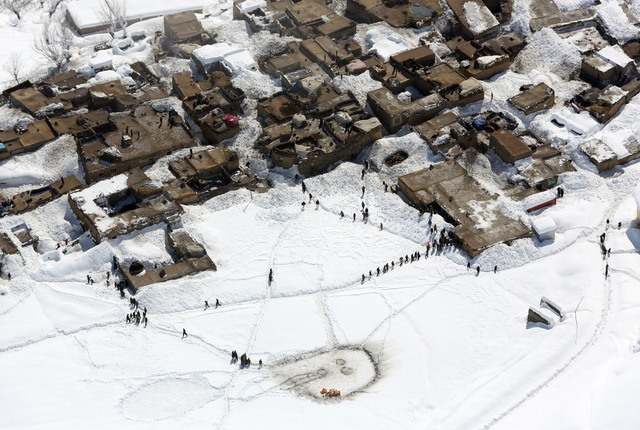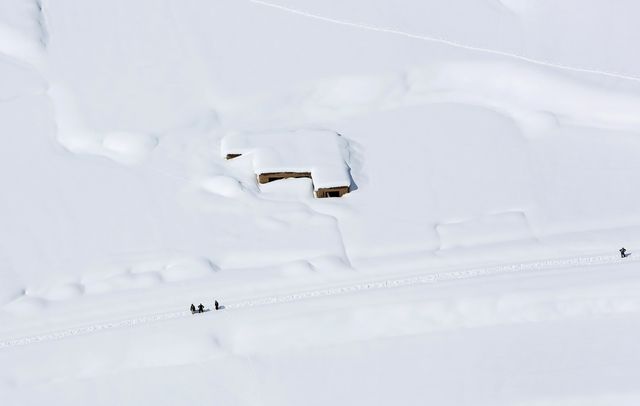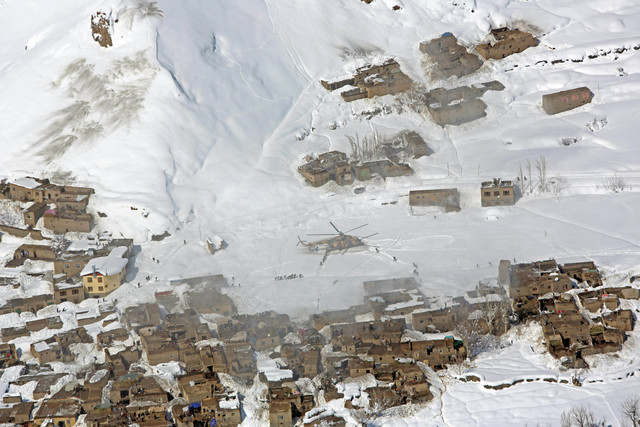Desperate Afghan avalanche survivors await rescue on roofs
PANJSHIR VALLEY, Afghanistan — In an endless sea of white, Afghan villagers waited on rooftops Friday, waving in desperation as helicopters swooped low over the avalanche-struck region. All around them, homes, people and livestock had vanished under the snow.
ADVERTISING
The avalanche in this impoverished corner of Afghanistan killed at least 168 people this week, with dozens succumbing to plummeting temperatures elsewhere. The depth of despair was captured by an Associated Press team traveling on one of the first aid flights to the area.
Army helicopters dropped bags filled with bread — the first food to reach hundreds of people in the far northern district of Paryan in Panjshir province, 100 kilometers (60 miles) northeast of the capital, Kabul.
As the helicopters touched down, whipping up clouds of powdered snow, men rushed forward for food, water and blankets while women watched from rooftops. Yellow plastic jerry cans of cooking oil, sacks of rice and rolled up blankets were passed from man to man.
On the return flights, the choppers took the injured to an international hospital in the southern reaches of the valley.
Nasar Khan, from Dara district, said his wife and four daughters were killed Tuesday when the snow crushed his roof and destroyed his house.
“My two sons rushed from another house to get us out, and only I survived,” he said through tears from his hospital bed.
Najibullah Haidery, head of the Afghan Red Crescent Society, said the scale of the disaster was staggering. Many among those who survived “managed to flee from their destroyed homes and buried villages, and now they have nothing,” he told the AP.
After days of severe weather across the central and northeastern provinces, the U.N.’s Office for the Coordination of Humanitarian Affairs reported Friday that 229 people have died in 18 of Afghanistan’s 34 provinces, with hundreds more left homeless.
Many more are cut off from help with roads blocked by deep snow, UNOCHA said.
Extremely cold temperatures were expected in many parts of the country in the coming days, and officials said harsh conditions and lack of machinery were hampering efforts to reach those who are trapped or injured. The army and some international agencies were delivering food, medicine, clothing and shelters to some of the hardest-hit areas, including far northern Badakhshan and Panjshir in the northeast.
Afghanistan has suffered through some three decades of war since the Soviet invasion in 1979. But natural disasters such as landslides, floods and avalanches have also taken a heavy toll on a country with little infrastructure or development outside of its major cities. Environmental degradation has worsened the problem in the north.
In northern Panjshir, those who escaped from homes buried by snow were stranded on rooftops. On one roof, a cow stood along with several people. In Paryan district, entire villages were almost invisible from the air.
The army flew up to six supply sorties Friday, the first since the snowstorms.
Hundreds of villages and thousands of people have been stranded without food or fresh water, and communication lines are down.
President Ashraf Ghani and his chief executive, Abdullah Abdullah, met with bereaved families in Panjshir. Ghani called for bulldozers to be sent to the region to clear roads and start digging people out. The Cabinet held an emergency meeting on the disaster in Panjshir to try to avoid the panic that followed a similar tragedy last year.
The number of dead was expected to climb with cold weather and difficult conditions hampering rescue efforts. UNOCHA said hundreds were still missing in affected provinces.
Mohammad Aslam Syas, deputy chief of the Afghanistan National Disaster Management Authority, said the helicopter drops were the only way to distribute supplies to people in Panjshir, which was still unreachable by road. He said 168 people were known to have died in the province’s northern Panjshir Valley.
Acting Gov. Abdul Rahman Kabiri said Ghani had inspected the damage to the northern reaches of the valley Friday and demanded machinery be sent in to clear roads.
The Salang Tunnel, which links Kabul to northern Afghanistan, has been closed for four days, and power supplies to the capital and neighboring provinces were curtailed severely. Officials said they were working on clearing the tunnel after avalanches at both ends.
The government declared a three-day mourning period, starting Saturday, for the dead.
Among recent major natural disasters in Afghanistan was a massive landslide in May that killed hundreds — with some estimates that 2,700 died, although there has never been a definitive count.
Another landslide in 2012 killed 71 people. Authorities were not able to recover most of the bodies and ended up declaring the site a mass grave.





